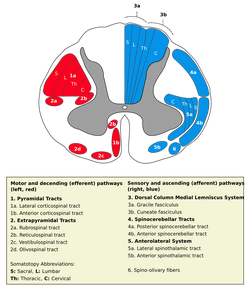Assessment |
Biopsychology |
Comparative |
Cognitive |
Developmental |
Language |
Individual differences |
Personality |
Philosophy |
Social |
Methods |
Statistics |
Clinical |
Educational |
Industrial |
Professional items |
World psychology |
Biological: Behavioural genetics · Evolutionary psychology · Neuroanatomy · Neurochemistry · Neuroendocrinology · Neuroscience · Psychoneuroimmunology · Physiological Psychology · Psychopharmacology (Index, Outline)
| Brain: Reticulospinal tract | ||
|---|---|---|
| Reticulospinal tract is 2b, in red, near center. | ||
| [[Image:|250px|center|]] | ||
| Latin | ' | |
| Gray's | subject # | |
| Part of | ||
| Components | ||
| Artery | ||
| Vein | ||
| BrainInfo/UW | hier-802 | |
| MeSH | [1] | |
The reticulospinal tract (or anterior reticulospinal tract) is an extrapyramidal motor tract which travels from the reticular formation.
Functions
1. Integrates information from the motor systems to coordinate automatic movements of locomotion and posture.
2. Facilitates and inhibits voluntary movement, influences muscle tone.
3. Mediates autonomic functions
4. Modulates pain impulses
Components
The tract is divided into two parts, the medial (or pontine) and lateral (or medullary) reticulospinal tracts (MRST and LRST).
- The MRST is caudal to the Superior Colliculus and is responsible for anti-gravity muscles. The fibers of this tract arise from the caudal pontine reticular nucleus and the oral pontine reticular nucleus and project to the lamina VII and lamina VIII of the spinal cord (BrainInfo)
- The LRST is rostral to the Superior Colliculus and is responsible for the muscles of movement. The fibers of this tract arise from the medullary reticular formation, mostly from the gigantocellular nucleus, and descend the length of the spinal cord in the anterior part of the lateral column. The tract terminates in the gray spinal laminae (BrainInfo).
The sensory tract conveying information in the opposite direction is known as the "spinoreticular tract".
Clinical significance
If the superior colliculus is damaged, it is called decerebration and causes decerebate rigidity.
The reticulospinal tracts also provide a pathway by which the hypothalamus can control sympathetic thoracolumbar outflow and parasympathetic sacral outflow.
External links
- BrainInfo reticulospinal tract[2], pontine reticulospinal tract [3], and medullary reticulospinal tract[4]</a>.
- http://www.lib.mcg.edu/edu/eshuphysio/program/section8/8ch6/s8ch6_29.htm
- http://www.mona.uwi.edu/fpas/courses/physiology/neurophysiology/The%20Reticulospinal%20Pathway.htm
Brain and spinal cord: neural tracts and fasciculi | |||||||||||||||
|---|---|---|---|---|---|---|---|---|---|---|---|---|---|---|---|
| Sensory/ ascending |
| ||||||||||||||
| Motor/ descending |
| ||||||||||||||
| Cerebellar |
| ||||||||||||||
| {| class="navbox collapsible nowraplinks" style="margin:auto; " | |||||||||||||||
| |||||||||||||||
|
|}
| This page uses Creative Commons Licensed content from Wikipedia (view authors). |
